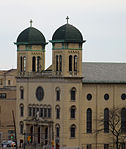Magenta Playground
1966 establishments in New York CityParks in the Bronx

Magenta Playground is a 1.21-acre (0.49-hectare) park in the Allerton section of The Bronx. It includes basketball and handball courts, a children's play area with a climbable seal sculpture, spray shower, and restrooms. Most of these were installed during a 1998 renovation.The land for the park was acquired by New York City via condemnation in 1960, and opened as a park in 1966. The park is adjacent to Bronx PS 41 and is operated jointly by NYC Parks and the NYC Department of Education. It is within Bronx City Council District 12. The name Magenta Playground dates to 1987, when the park was renamed.
Excerpt from the Wikipedia article Magenta Playground (License: CC BY-SA 3.0, Authors, Images).Magenta Playground
Olinville Avenue, New York The Bronx
Geographical coordinates (GPS) Address Nearby Places Show on map
Geographical coordinates (GPS)
| Latitude | Longitude |
|---|---|
| N 40.8737358 ° | E -73.8680525 ° |
Address
Olinville Avenue 3300
10467 New York, The Bronx
New York, United States
Open on Google Maps










